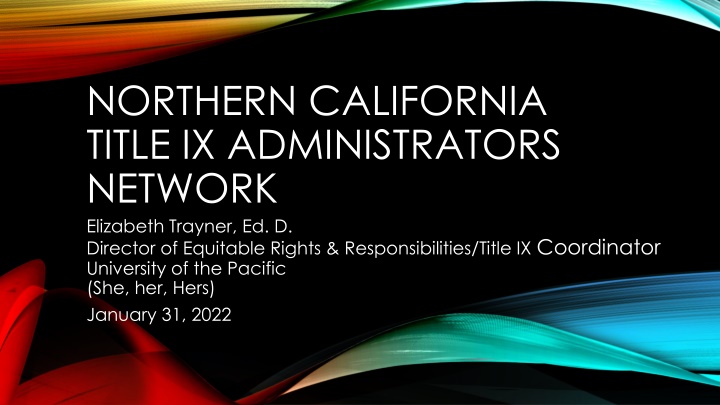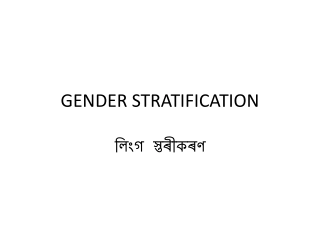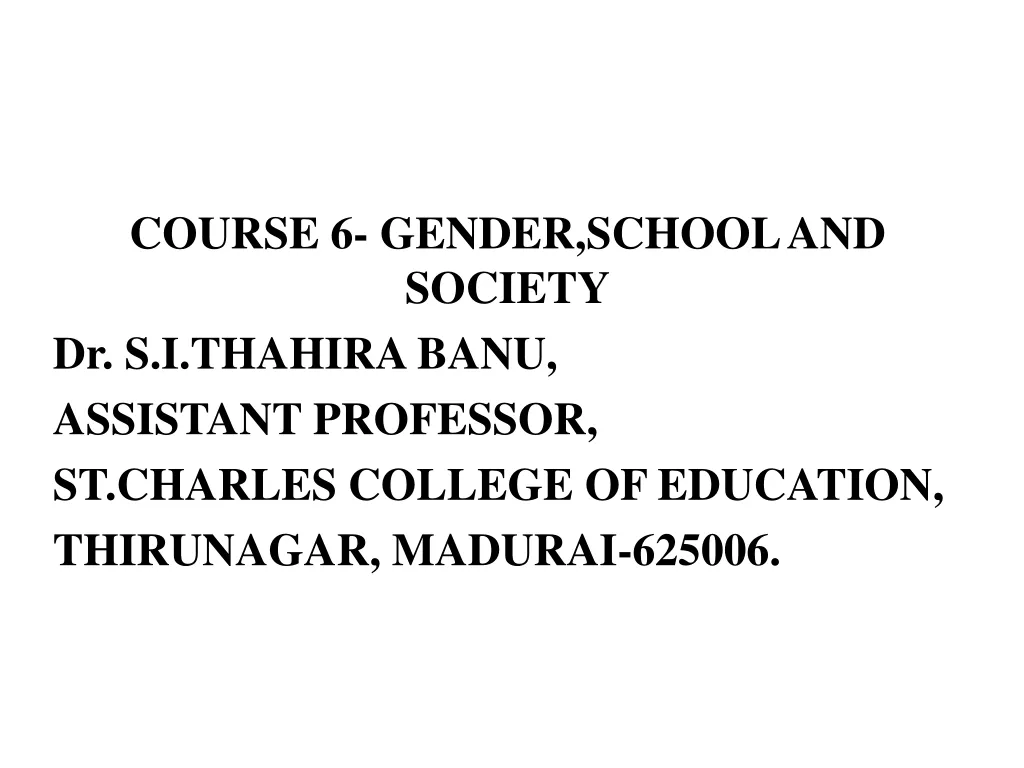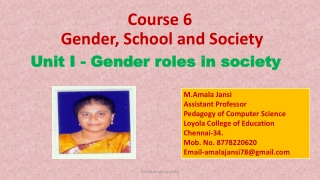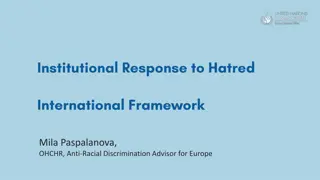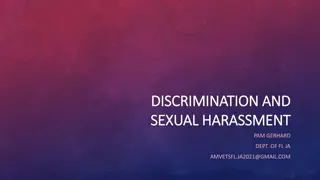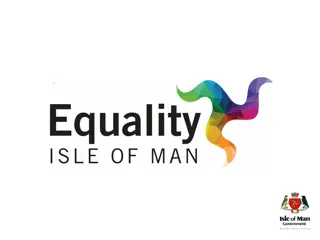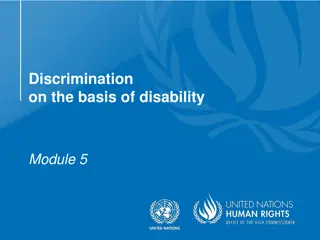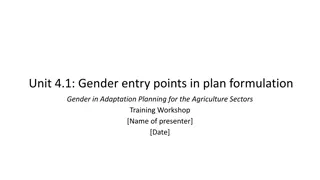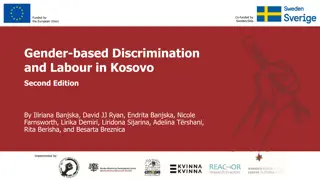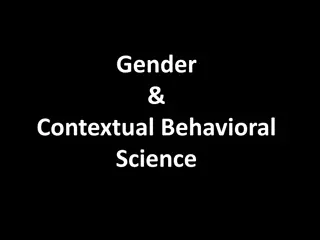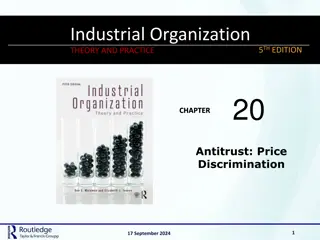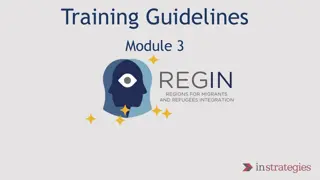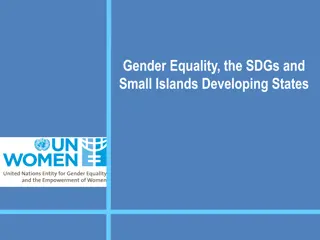Addressing Gender Discrimination in Education
Promoting inclusivity and equity in education through actions such as using gender-neutral language, creating balanced curriculum, and encouraging participation across all genders.
Download Presentation

Please find below an Image/Link to download the presentation.
The content on the website is provided AS IS for your information and personal use only. It may not be sold, licensed, or shared on other websites without obtaining consent from the author.If you encounter any issues during the download, it is possible that the publisher has removed the file from their server.
You are allowed to download the files provided on this website for personal or commercial use, subject to the condition that they are used lawfully. All files are the property of their respective owners.
The content on the website is provided AS IS for your information and personal use only. It may not be sold, licensed, or shared on other websites without obtaining consent from the author.
E N D
Presentation Transcript
NORTHERN CALIFORNIA TITLE IX ADMINISTRATORS NETWORK Elizabeth Trayner, Ed. D. Director of Equitable Rights & Responsibilities/Title IX Coordinator University of the Pacific (She, her, Hers) January 31, 2022
DISCUSSION ITEMS CA SB 493 New NCAA Trans Student-Athlete Guidance What else is on your mind?
GENDER DISCRIMINATION IN THE CLASSROOM
LANGUAGE Use gender neutral terms and inclusive language Inclusive examples Description of roles
CURRICULUM Create materials and activities that are inclusive, representative, and appropriately gender-affirmative, sensitive, and balanced. Monitor and revise curriculum to promote full development and avoid perpetuating stereotypes. Include a unit on gender bias, and use examples of incidents of negative stereotyping as teachable moments. Explore how the media contributes to gender bias and stereotyping. Encourage students to work together across difference. Avoid assigning groups by gender.
EQUITY OF PARTICIPATION Encourage participation across the board. Assign tasks that equally place students in non-traditional learning situations.
SOCIALIZATION AND FEEDBACK Encourage the same positive behaviors from all genders. Avoid assigning tasks that involve stereotyped gender roles Letters of recommendation
SYLLABUS EXAMPLE The University of the Pacific is committed to fostering a community in which all members feel respected and safe. Sexual and gender-based harassment, misconduct, and violence are inconsistent with our mission and values and will not be tolerated. The university believes that it is our community s responsibility to prevent, educate, and effectively respond, and it is a responsibility the university takes very seriously. We recognize that a culture of respect and safety requires that each one of us students, staff, and faculty do our part when something occurs that is not consistent with our community s values. It is imperative that individuals affected by sexual and gender-based harassment, misconduct, and violence know they are not alone that our community is here to help. Pacific community members are encouraged to report incidents of sexual and gender-based harassment, misconduct, and violence to the Title IX Office. The university will take steps to appropriately address such reports and support affected community members. Together, we can take a stand to be a part of a community in which all members feel respected and safe. The full policy can be found by clicking on this link.
SYLLABUS EXAMPLE How to Report We encourage you to report all forms of sexual misconduct committed by or against any member of our community. Reporting will not change what happened to you or a member of our community, but it may help stop it from happening to someone else. Confidential Reporting The Victim Advocate, therapists from Counseling and Psychological Services (working in their capacity as therapists), student health services, the University Ombuds, and the Multi-Faith Chaplain are confidential reporting resources. They can speak with you confidentially, link a victim to support resources, and explain the various options for filing a formal complaint. Reporting to the University The University of the Pacific takes incidents of sexual misconduct very seriously and encourages reporting. Survivors are free to report instances of sexual misconduct to the university regardless of whether or not they choose to press formal charges with law enforcement. All faculty and staff (with the exception of confidential resources) are required to report incidents of sexual misconduct to the Title IX Coordinator. Click here for a link to the online reporting form.
SYLLABUS EXAMPLE Campus Reporting Contact Information Title IX Coordinator: Elizabeth Trayner: etrayner@pacific.edu; 209.946.7770 or 1.888.383.2765 (toll-free) Victim Advocate (3-City): 209.403.0250 *Confidential Reporting Stockton Campus Department of Public Safety: 209.946.2537 Sacramento Campus Department of Public Safety: 916.739.7200 San Francisco Campus Department of Public Safety: 415.929.6456 NOTE: Reporting to Public Safety is not the same as pressing charges against an offender.
SYLLABUS EXAMPLE FOR PRONOUN USAGE AND NAMES Consistent with Pacific s core values, Pacific is committed to providing a welcoming and safe environment for all genders. Students seeking to change their name used in their student record, please contact the Pride Resource Center at pridecenter@pacific.edu or the Office of Title IX at titleix@pacific.edu.
Maxon v. Fuller Theological Seminary, (9th Cir. Dec. 13, 2021) Both of the plaintiffs were in same-sex marriages Plaintiffs sued Fuller Theological Seminary after being dismissed from the institution Fuller s Sexual Standards state sexual union must be reserved for marriage, which is the covenant union between one man and one woman and outline that the expectation that all members of the school community abstain from what it holds to be unbiblical sexual practices. District court dismissed plaintiffs complaint religious exemption CASE LAW UPDATES
Maxon v. Fuller Theological Seminary, (9th Cir. Dec. 13, 2021) Plaintiffs made several arguments with respect to the T9 exemption to combat the religious exemption but were unsuccessful Argument 1 Fuller does not qualify for the religious exemption because it is controlled by its own board of trustees and not a distinct external organization Response this is not required and the T9 exemption encompasses those educational institutions controlled by their own religiously affiliated board of trustees CASE LAW UPDATES
Maxon v. Fuller Theological Seminary, (9th Cir. Dec. 13, 2021) Argument 2 Fuller s discriminatory actions toward Plaintiffs do not fall within the exemption Response this argument fails because the purpose of the exemption is to shield Defendants religiously motivated decisions. Argument 3 Fuller did not provide written notice of their religious exemption to the DOE Response this is not required. District court s decision to dismiss is affirmed. CASE LAW UPDATES
Brown v. Arizona (9th Cir. 2022) Ms. Brown was physically assaulted by a U of A student, her former boyfriend, and a football player for the University. The assault against Ms. Brown took place at the male student s private off-campus apartment. Prior to her assault, the male student had assaulted two other females on campus Ms. Brown sued the University claiming, among other things, that the University failed to adequately respond to the prior two assaults which in turn led to her own. CASE LAW UPDATES
Brown v. Arizona (9th Cir. 2022) University filed a motion for summary judgment because the assault took place off-campus District court granted and Brown appealed Brown s arguments: University s deliberate indifference toward the male student s prior abuse gave him the opportunity to abuse her Court relied upon the below: The Supreme Court has held that Title IX liability exists for student-on- student harassment where an educational institution "exercises substantial control over both the harasser and the context in which the known harassment occurs." CASE LAW UPDATES
Brown v. Arizona (9th Cir. 2022) The court found that prior case law requires Brown to prove the University controlled the context in which her abuse occurred-not just the context of Bradford's other assaults. The court also stated if this requirement is not met, the institution has not "expose[d] its students to harassment or cause[d] them to undergo [harassment] under the [institution]'s programs. Brown was not arguing that the University controlled the off- campus environment in which she was assaulted Rather that the University should be liable because it allowed the individual to remain a student after receiving various reports against him involving physical abuse CASE LAW UPDATES
Brown v. Arizona (9th Cir. 2022) Brown s arguments were not persuasive. It would be unreasonable to conclude that Title IX gives educational institutions adequate notice that accepting federal education funds imposes on them liability for what happens between students off campus, unconnected to any school event or activity. Decision affirmed. CASE LAW UPDATES
THE IMPACT OF SUPPORTIVE MEASURES The Title IX Office receives a group of late reports of sexual violence that occurred early in the semester, or even before, but they were not reported until the students were already significantly behind/failing the course. The Title IX Coordinator goes back to the beginning of the semester trying to coordinate extensions, make-ups, extra credit opportunities to support the student. Added to that, there have been some off-campus, non-Title IX events with students requesting escalating accommodations. For example, within the same class, first requesting an extension due to sickness, then a funeral, then COVID, and ultimately due to domestic violence.
THE IMPACT OF SUPPORTIVE MEASURES The Title IX Office is also alerted to a group of students flagged by an outside vendor as demonstrating suspicious banking and identity practices associated with financial fraud. These same students are demanding accommodations related to sexual violence. The campus practice to is be as trauma-informed as possible, and give students the benefit of the doubt and accommodate them. The purpose in doing so is to help elevate failing grades, which could assist them in obtaining additional financial aid they would lose but for the Title IX supportive measures. What are the pros and cons of such an approach?
JUST A DREAM A student comes in and reports that they have been sexually assaulted by another student in their on campus residence hall. After speaking with the Title IX Coordinator, the Complainant files a formal complaint. The Title IX Coordinator sends out a Notice of Investigation to the Parties and launches an investigation. The investigators speak with the Complainant and schedule a follow up meeting after speaking with the first two witnesses in order to make sense of some of the conflicting information they are beginning to hear. During the second meeting with the Complaint, they state that they no longer want to participate in the investigation. They mention that maybe it didn t happen and it was just a very vivid dream. What would you do if you were the investigator? What would you do if the investigators brought this information to you as the Title IX Coordinator?
JUST A DREAM The Title IX Coordinator makes the determination to dismiss the case in light of the totality of the information they received. Once the Respondent receives the letter of dismissal they contact the Title IX Coordinator to state that they would like to file a claim against the original Complainant for False Reporting. What would you do?
FACULTY CHAIR Dr. Madrigal is the current Chair of the Science Department. Dr. Sullivan served as Chair from 2011-2021. Dr. Madrigal reports that she has experienced a long pattern of sexual harassment by Dr. Sullivan dating back to the time when she first interviewed for a position at the university. She is one of two female faculty members in the department. During the interview process she was asked if she was planning to have children because it was a small department and taking leave would be a burden to the rest of the faculty. She was further told that, if she decided to have children, it would be best if she had them during the summer so that the teaching schedule wouldn t be impacted. After she arrived on campus Dr. Madrigal was invited to a dinner party at Dr. Sullivan s. She was eager to interact with the other faculty members in a more informal setting but, when she arrived she found that she was relegated to serving the other guests and cleaning up.
FACULTY CHAIR Dr. Madrigal shared several similar stories of what occurred over the course of her first 10 years at the university. When she was appointed as Chair, she thought things would change. However, now Dr. Sullivan is badmouthing her behind her back with the other faculty in the department and has been undermining her authority. She has not reported anything to the university previously. She s not sure what she wants to do but she wants the harassment to stop. What would be your approach?
REFERENCES Huang, B. (2016). Gender bias faced by girls and what we can do: One student s perspective and appended information from the center. http://smhp.psych.ucla.edu/pdfdocs/genderbias.pdf The University of Arizona Commission on the Status of Women. Avoiding gender bias in reference writing. https://csw.arizona.edu/sites/default/files/avoiding_gender_bias_in_letter_of _reference_writing.pdf
THANK YOU These materials and all discussions of these materials are for instructional purposes only and do not constitute legal advice. If you need legal advice, you should contact your attorney. All attendees at the January 31, 2022 virtual meeting of the Northern California Title IX Administrators Network are hereby granted permission to post a copy of these materials to their institution s website solely for purposes of compliance with 34 CFR 106.45(b)(10)(i)(D). These materials are not intended to be used by anyone for their own training purposes. Use of this material for proprietary reasons is strictly prohibited.
